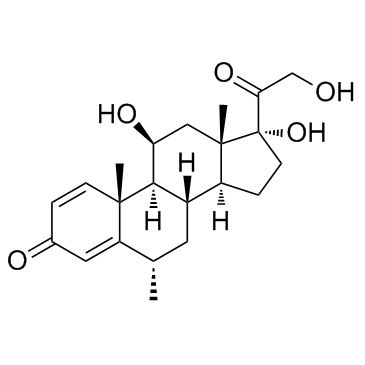83-43-2
| 中文名 | 6α-甲基泼尼松龙 |
|---|---|
| 英文名 | 6α-methylprednisolone |
| 中文别名 |
甲基泼尼松龙
11β,17α,21-三羟基-6α-甲基-1,4-孕甾二烯-3,20-二酮 甲基强的松龙 甲基氢化泼尼松 6α-甲基-11β,17α,21-三羟基-1,4-孕甾二烯-3,20-二酮 甲泼尼龙 |
| 英文别名 |
(6S,8S,9S,10R,11S,13S,14S,17R)-11,17-dihydroxy-17-(2-hydroxyacetyl)-6,10,13-trimethyl-7,8,9,11,12,14,15,16-octahydro-6H-cyclopenta[a]phenanthren-3-one
MFCD00010591 EINECS 201-476-4 Methylprednisolone 6alpha-methylprednisolone |
| 描述 | Methylprednisolone是皮质类固醇,可作用于糖皮质激素受体。 |
|---|---|
| 相关类别 | |
| 参考文献 |
| 密度 | 1.3±0.1 g/cm3 |
|---|---|
| 沸点 | 571.8±50.0 °C at 760 mmHg |
| 熔点 | 228-237°C (dec.) |
| 分子式 | C22H30O5 |
| 分子量 | 374.471 |
| 闪点 | 313.7±26.6 °C |
| 精确质量 | 374.209320 |
| PSA | 94.83000 |
| LogP | 1.99 |
| 外观性状 | 白色至灰白色结晶粉末 |
| 蒸汽压 | 0.0±3.6 mmHg at 25°C |
| 折射率 | 1.603 |
| 储存条件 | 本品应密封干燥保存。 |
| 水溶解性 | chloroform/methanol (9:1): 50 mg/mL, clear, faintly yellow |
| 分子结构 | 1、 摩尔折射率:100.08 2、 摩尔体积(m3/mol):291.4 3、 等张比容(90.2K):804.8 4、 表面张力(dyne/cm):58.1 5、 极化率(10-24cm3):39.67 |
| 计算化学 | 1.疏水参数计算参考值(XlogP):无 2.氢键供体数量:3 3.氢键受体数量:5 4.可旋转化学键数量:2 5.互变异构体数量:9 6.拓扑分子极性表面积94.8 7.重原子数量:27 8.表面电荷:0 9.复杂度:754 10.同位素原子数量:0 11.确定原子立构中心数量:8 12.不确定原子立构中心数量:0 13.确定化学键立构中心数量:0 14.不确定化学键立构中心数量:0 15.共价键单元数量:1 |
| 更多 | 1. 性状:无色结晶。 2. 密度(g/mL,25/4℃):不确定 3. 相对蒸汽密度(g/mL,空气=1):不确定 4. 熔点(ºC):228~237℃ 5. 沸点(ºC,常压):不确定 6. 沸点(ºC,5.2kPa):不确定 7. 折射率:不确定 8. 闪点(ºC):不确定 9. 比旋光度(º):[α]D20 +83°(二氧六环中)。 10. 自燃点或引燃温度(ºC):不确定 11. 蒸气压(kPa,25ºC):不确定 12. 饱和蒸气压(kPa,60ºC):不确定 13. 燃烧热(KJ/mol):不确定 14. 临界温度(ºC):不确定 15. 临界压力(KPa):不确定 16. 油水(辛醇/水)分配系数的对数值:不确定 17. 爆炸上限(%,V/V):不确定 18. 爆炸下限(%,V/V):不确定 19. 溶解性:略微溶于乙醇、二氧六环、甲醇,微溶于丙酮、氯仿,极微溶于乙醚,不溶于水 |
Synonym:Medro Section 2 - COMPOSITION, INFORMATION ON INGREDIENTS
Risk Phrases: 40 Section 3 - HAZARDS IDENTIFICATION EMERGENCY OVERVIEW
Limited evidence of a carcinogenic effect. Potential Health Effects Eye: May cause eye irritation. Skin: Harmful if absorbed through the skin. Ingestion: Harmful if swallowed. Inhalation: Harmful if inhaled. May cause irritation of the respiratory tract with burning pain in the nose and throat, coughing, wheezing, shortness of breath and pulmonary edema. Chronic: Not available. Section 4 - FIRST AID MEASURES Eyes: Flush eyes with plenty of water for at least 15 minutes, occasionally lifting the upper and lower eyelids. Get medical aid. Skin: Get medical aid. Flush skin with plenty of water for at least 15 minutes while removing contaminated clothing and shoes. Ingestion: Get medical aid. Wash mouth out with water. Inhalation: Remove from exposure and move to fresh air immediately. If not breathing, give artificial respiration. If breathing is difficult, give oxygen. Get medical aid. Notes to Physician: Section 5 - FIRE FIGHTING MEASURES General Information: As in any fire, wear a self-contained breathing apparatus in pressure-demand, MSHA/NIOSH (approved or equivalent), and full protective gear. Extinguishing Media: Use foam, dry chemical, or carbon dioxide. Section 6 - ACCIDENTAL RELEASE MEASURES General Information: Use proper personal protective equipment as indicated in Section 8. Spills/Leaks: Vacuum or sweep up material and place into a suitable disposal container. Section 7 - HANDLING and STORAGE Handling: Avoid breathing dust, vapor, mist, or gas. Avoid contact with skin and eyes. Storage: Store in a cool, dry place. Store in a tightly closed container. Section 8 - EXPOSURE CONTROLS, PERSONAL PROTECTION Engineering Controls: Use adequate ventilation to keep airborne concentrations low. Exposure Limits CAS# 83-43-2: Personal Protective Equipment Eyes: Not available. Skin: Wear appropriate protective gloves to prevent skin exposure. Clothing: Wear appropriate protective clothing to prevent skin exposure. Respirators: Follow the OSHA respirator regulations found in 29 CFR 1910.134 or European Standard EN 149. Use a NIOSH/MSHA or European Standard EN 149 approved respirator if exposure limits are exceeded or if irritation or other symptoms are experienced. Section 9 - PHYSICAL AND CHEMICAL PROPERTIES Physical State: Powder Color: white Odor: Not available. pH: Not available. Vapor Pressure: Not available. Viscosity: Not available. Boiling Point: Not available. Freezing/Melting Point: 227-231 deg C Autoignition Temperature: Not available. Flash Point: Not available. Explosion Limits, lower: Not available. Explosion Limits, upper: Not available. Decomposition Temperature: Solubility in water: Insoluble. Specific Gravity/Density: Molecular Formula: C22H30O5 Molecular Weight: 374.207 Section 10 - STABILITY AND REACTIVITY Chemical Stability: Stable. Conditions to Avoid: Incompatible materials. Incompatibilities with Other Materials: Strong oxidizing agents, acids, acid chlorides, carbon dioxide, acid anhydrides. Hazardous Decomposition Products: Nitrogen oxides, carbon monoxide, carbon dioxide. Hazardous Polymerization: Will not occur. Section 11 - TOXICOLOGICAL INFORMATION RTECS#: CAS# 83-43-2: TU4146000 LD50/LC50: CAS# 83-43-2: Oral, rat: LD50 = >4 gm/kg. Carcinogenicity: 6-alpha-Methylprednisolone - Not listed by ACGIH, IARC, or NTP. Other: See actual entry in RTECS for complete information. Section 12 - ECOLOGICAL INFORMATION Section 13 - DISPOSAL CONSIDERATIONS Dispose of in a manner consistent with federal, state, and local regulations. Section 14 - TRANSPORT INFORMATION IATA No information available. IMO No information available. RID/ADR No information available. Section 15 - REGULATORY INFORMATION European/International Regulations European Labeling in Accordance with EC Directives Hazard Symbols: XN Risk Phrases: R 40 Limited evidence of a carcinogenic effect. Safety Phrases: S 36/37 Wear suitable protective clothing and gloves. S 45 In case of accident or if you feel unwell, seek medical advice immediately (show the label where possible). WGK (Water Danger/Protection) CAS# 83-43-2: No information available. Canada CAS# 83-43-2 is listed on Canada's NDSL List. CAS# 83-43-2 is not listed on Canada's Ingredient Disclosure List. US FEDERAL TSCA CAS# 83-43-2 is listed on the TSCA inventory. SECTION 16 - ADDITIONAL INFORMATION N/A |
|
毒理学数据: 1、急性毒性: 人肠道TDLO:2400 ug/kg;人静脉TDLO:60 mg/kg/3D-I 人静脉TDLO:20 mg/kg/45W-C 大鼠口径LD50:>4mg/kg; 小鼠腹腔LD50:2292mg/kg; 2、其他多剂量毒性: 狗口径TDL0:210 mg/kg/6W-I CHEMICAL IDENTIFICATION
HEALTH HAZARD DATAACUTE TOXICITY DATA
|
| 个人防护装备 | Eyeshields;Gloves;type N95 (US);type P1 (EN143) respirator filter |
|---|---|
| 危害码 (欧洲) | Xi |
| 风险声明 (欧洲) | R36/37/38 |
| 安全声明 (欧洲) | S22-S36 |
| 危险品运输编码 | NONH for all modes of transport |
| WGK德国 | 2 |
| RTECS号 | TU4146000 |


